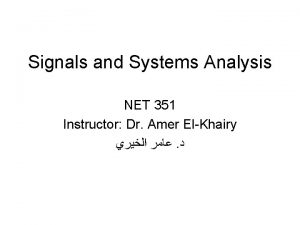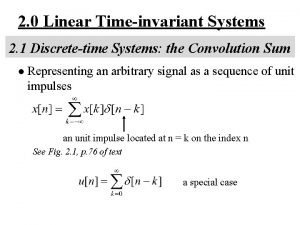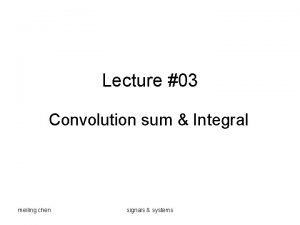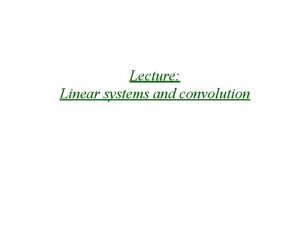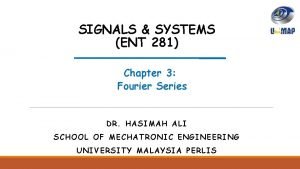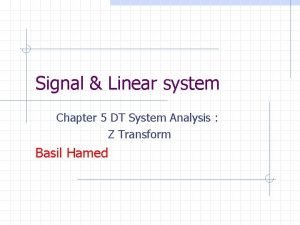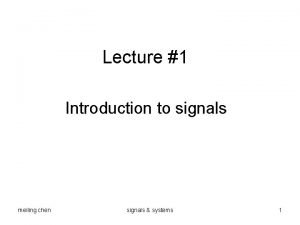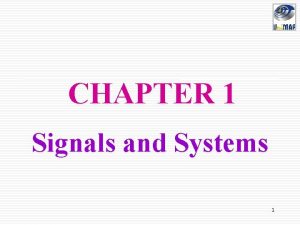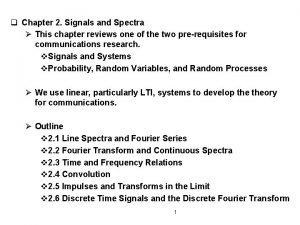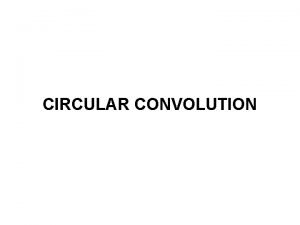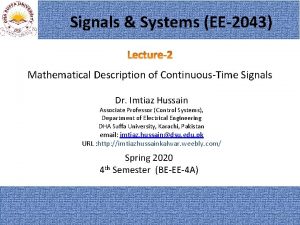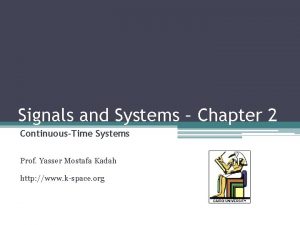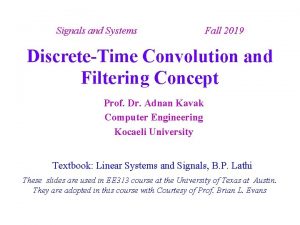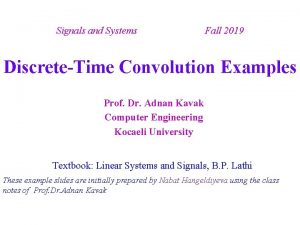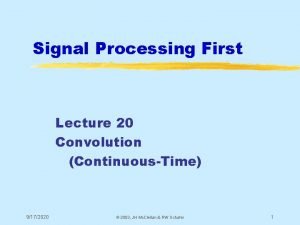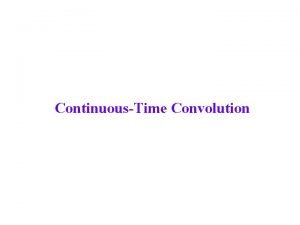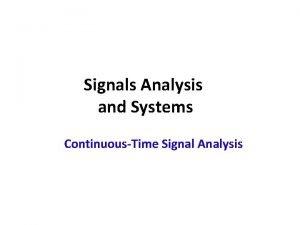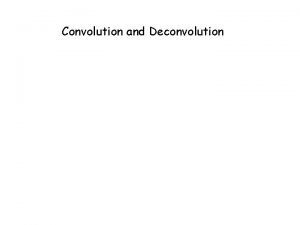Signals and Systems Fall 2019 ContinuousTime Convolution Prof











- Slides: 11

Signals and Systems Fall 2019 Continuous-Time Convolution Prof. Dr. Adnan Kavak Computer Engineering Kocaeli University Textbook: Linear Systems and Signals, B. P. Lathi These slides are used in EE 313 course at the University of Texas at Austin. They are adopted in this course with Courtesy of Prof. Brian L. Evans

Convolution Integral • Commonly used in engineering, science, math • Convolution properties – – Commutative: f 1(t) * f 2(t) = f 2(t) * f 1(t) Distributive: f 1(t) * [f 2(t) + f 3(t)] = f 1(t) * f 2(t) + f 1(t) * f 3(t) Associative: f 1(t) * [f 2(t) * f 3(t)] = [f 1(t) * f 2(t)] * f 3(t) Shift: If f 1(t) * f 2(t) = c(t), then f 1(t) * f 2(t - T) = f 1(t - T) * f 2(t) = c(t - T). – Convolution with impulse, f(t) * d(t) = f(t) – Convolution with shifted impulse, f(t) * d(t-T) = f(t-T) 4 -2 important later in modulation

Graphical Convolution Methods • From the convolution integral, convolution is equivalent to – Rotating one of the functions about the y axis – Shifting it by t – Multiplying this flipped, shifted function with the other function – Calculating the area under this product – Assigning this value to f 1(t) * f 2(t) at t 4 -3

Graphical Convolution Example • Convolve the following two functions: f(t) g(t) 3 2 * t t 2 -2 2 • Replace t with t in f(t) and g(t) • Choose to flip and slide g(t) since it is simpler and symmetric 3 g(t-t) • Functions overlap like this: 2 f(t) -2 + t 2+t 2 t 4 -4

Graphical Convolution Example • Convolution can be divided into 5 parts I. t < -2 • • Two functions do not overlap Area under the product of the functions is zero 3 2 -2 + t • • f(t) 3 Part of g(t) overlaps part of f(t) Area under the product of the functions is t 2 2+t -2 t < 0 II. g(t-t) 2 -2 + t f(t) 2+t t 2 4 -5

Graphical Convolution Example III. 0 t < 2 • • Here, g(t) completely overlaps f(t) Area under the product is just 3 2 f(t) 2 2+t -2 + t IV. 2 t < 4 • • Part of g(t) and f(t) overlap Calculated similarly to -2 t < 0 t 4 – • • g(t) and f(t) do not overlap Area under their product is zero g(t-t) t 3 g(t-t) 2 f(t) -2 + t 2+t 4 -6

Graphical Convolution Example • Result of convolution (5 intervals of interest): y(t) 6 t -2 0 2 4 4 -7

Convolution Demos • Johns Hopkins University Demonstrations http: //www. jhu. edu/~signals Convolution applet to animate convolution of simple signals and hand-sketched signals Convolve two rectangular pulses of same width gives a triangle (see handout E) • Some conclusions from the animations Convolution of two causal signals gives a causal result Non-zero duration (called extent) of convolution is the sum of extents of the two signals being convolved 4 -8

Example: Transmit One Bit • Transmission over communication channel (e. g. telephone line) is analog receive ‘ 0’ bit input Tp t x(t) -A A t Tp ‘ 1’ bit t Communication Channel Model channel as LTI system with impulse response h(t) Assume that Th < Tp output Th y(t) t -A Th receive‘ 1’ bit A Th 1 Th Th+Tp t Th Th+Tp 4 -9 t

Example: Transmit Two Bits (Interference) • Transmitting two bits (pulses) back-to-back will cause overlap (interference) at the receiver * A = 1 Th+Tp 2 Tp Tp ‘ 1’ bit t Th t -A Th ‘ 0’ bit Assume that Th < Tp • How do we prevent intersymbol interference at the receiver? t Tp ‘ 1’ bit ‘ 0’ bit intersymbol interference 4 - 10

Example: Transmit Two Bits (No Interference) • Prevent intersymbol interference by waiting Th seconds between pulses (called a guard period) * A = 1 Th+Tp Tp ‘ 1’ bit Th+Tp Th t t -A Th ‘ 0’ bit Assume that Th < Tp t Th Tp ‘ 1’ bit ‘ 0’ bit • Disadvantages? 4 - 11
 Convolution sum in signals and systems
Convolution sum in signals and systems Convolution sum in signals and systems
Convolution sum in signals and systems Convolution integral
Convolution integral Communicative signals and informative signals
Communicative signals and informative signals Communicative signals and informative signals
Communicative signals and informative signals Communicative and informative signals
Communicative and informative signals Convolution linearity
Convolution linearity Sin in exponential form
Sin in exponential form Signals and systems oppenheim solutions chapter 5
Signals and systems oppenheim solutions chapter 5 Signals
Signals Precedence rule in signals and systems
Precedence rule in signals and systems Synthesis equation fourier series
Synthesis equation fourier series
